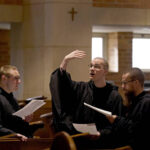
Published October 9, 2023
The Synod on Synodality and the War of the Conciliar Succession
Nothing was more predictable than that Synod-2023 would reignite what I once dubbed (with apologies to the 18th-century Habsburgs) the “War of the Conciliar Succession”: the intra-Catholic war over the legacy of the Second Vatican Council. The war’s first skirmishes were fought during the Council itself; the war has blown hot and cold ever since; and beneath the surface bonhomie of the Synod’s first week, the war continues at Synod-2023. Historically knowledgable Catholics know that all ecumenical councils take at least a century to digest, so in one sense it’s not surprising that the struggle for defining the meaning of Vatican II continues, sixty-one years after the Council’s opening. The War of the Conciliar Succession has been exacerbated, however, by the cultural circumstances in which it has been fought, as well as by the dumbing-down of argument into epithet caused by postmodern communications.
As the Synod ended its first week of work and its participants sought some respite from what one described as “the tyranny of dialogue,” two articles appeared that signaled a hardening of positions in the War of the Conciliar Succession. Curiously, however, these articles suggested, however inadvertently, the possibility of a strange convergence of views between Catholic factions usually found at opposite ends of the argument over Vatican II’s intentions, teachings, and consequences.
The first article was written by veteran Vaticanista Gerard O’Connell, whose work appears regularly in the Jesuit-run magazine, America, and on its affiliated website. Mr. O’Connell is well-sourced. He is also very enthusiastic about the current pontificate, to the point where some regard his dispatches as reliable, if unofficial, reflections of the thinking of Pope Francis and his closest counsellors.
Synod-2023’s opening on October 4—which included a great procession through St. Peter’s Square—put Mr. O’Connell in mind of a similar pageant on October 11, 1962, when a grand procession of some 2,500 bishops began the Solemn Opening the Second Vatican Council. There was a significant difference this time, however. For as the Irish-born journalist noted, among those participating in Synod-2023’s opening procession were “nonbishops, including women and lay men. . . . as full members of the Synod.” And that, O’Connell wrote, was “a sign of the progress” Pope Francis has made in developing Vatican II’s “potential for the renewal of the life of the Church.”
To which close students of the Second Vatican Council, and of modern Christian history more broadly, might respond, “How, exactly, is that the case with respect to Vatican II? And how have similar experiments in ecclesiastical ‘progress’ worked out?”
One of the signal accomplishments of Vatican II was to rebalance the Catholic Church’s theological self-understanding, its “ecclesiology,” by reemphasizing the sacramentally-conferred authority of bishops and their common (or “collegial”) responsibility, with and under the Bishop of Rome, for the world Church. The First Vatican Council, which began its work in 1869, had highlighted the authority of the pope with its teaching on his universal power of jurisdiction (a bold counter-stroke to the encroachments of modern states in local Church affairs), and by solemnly affirming the infallibility enjoyed by the pope when, under carefully delimited circumstances, he defined a matter of faith or morals. But when the Franco-Prussian War led to the abrupt suspension of Vatican I in 1870, that council’s teaching on papal authority was not complemented by a parallel teaching on the authority of bishops. The result over the next nine decades was an imbalance, in which local bishops were often imagined to be branch managers of Catholic Church, Inc., executing instructions from the Chief Executive Officer (the pope) at the corporation’s Roman headquarters, but with little capacity for initiative on their own.
Vatican II and its Dogmatic Constitution on the Church (Lumen Gentium) corrected this imbalance by teaching that the authority sacramentally conferred on bishops by the reception of Holy Orders in the highest degree constitutes the world episcopate as a college: a college that, as successor to the apostolic “college” composed of Christ’s apostles, shares full authority for the universal Church, with and under the Bishop of Rome. The purpose of the Synod of Bishops, created by Pope Paul VI in 1965, was to be one expression of that episcopal “collegiality.”
At the same time, Lumen Gentium taught that the Catholic laity’s role in the mission of the Church was considerably broader and deeper than that old bromide, to “pray, pay, and obey” (or, as an aristocratic English clericalist put it in the late 19th century, “to hunt, to shoot, and to entertain”). According to the Dogmatic Constitution on the Church and the Council’s Decree on the Apostolate of the Laity (Apostolicam Actuositatem), lay Catholics, by virtue of their baptism, receive the Great Commission of Matthew 28:19–20 and are called to evangelize the world. That conciliar insight was deepened and extended by Pope John Paul II in the 1990 encyclical Redemptoris Missio. While confirming the Council’s teaching that every baptized Catholic is called to missionary discipleship in a world where “mission territory” is everywhere, John Paul emphasized that there are fields of missionary endeavor that are primarily the responsibility of the laity—such as the worlds of culture, politics, economics, and the media.
These core conciliar teachings raise two sets of serious questions about Mr. O’Connell’s enthusiasms over the demographics of Synod-2023.
First: Isn’t the collegial episcopal authority emphasized by Vatican II diluted when a body formed as a Synod of Bishops includes “nonbishops, especially women and lay men . . . as full members of the Synod”? How does that form of Synod express the collegial authority of the bishops in union with the Bishop of Rome for the governance of the universal Church?
Second: Doesn’t the lay vocation to evangelize the world become attenuated when lay men and women imagine that their baptismal role is to run, or even redesign, the Church? Isn’t that a form of the “clericalism” against which Pope Francis regularly inveighs? How have similar exercises worked out in the recent past?
To the last question: A sober look at the parlous state of the Catholic Church in Germany—hundreds of thousands of formal defections last year; 2 percent Sunday Mass attendance—ought to be a warning about what happens when a powerful and well-funded lay body (in this case, the Zentralkomitee der deutschen Katholiken, or Central Committee of German Catholics) acts as a de facto parallel authority to the episcopate—and then asserts its capacity to upend settled Catholic doctrine and pastoral practice, by making concession after concession to the spirit of the age through a “synodal” methodology of Church governance. (An even more lurid example of what can follow from the unraveling of classic Christian patterns of authority comes from the Church of England, where the dilution of episcopal authority has run parallel, not only to the national apostasy evident in empty churches, but to such once-unimaginable goings-on as Canterbury Cathedral, site of the martyrdom of St. Thomas Becket, being turned into a disco playing the music of Britney Spears, the Spice Girls, and Shania Twain amidst a light show. [You can pre-order your tickets here].)
Gerard O’Connell’s article on the opening of Synod-2023 concluded by drawing an analogy between Pope John XXIII’s recollection that the idea of an ecumenical council came to him as an inspiration of the Holy Spirit, and Pope Francis’s constant invocation of the Holy Spirit, which the pope repeated in his October 4 homily when he spoke of the Spirit who “often shatters our expectations to create something new that surpasses our predictions and negativity.” That is certainly a welcome reminder, and for everyone. Taken seriously, it should prompt reflections on the starboard side of the Barque of Peter as to why the Second Vatican Council was necessary, and why both Pope John Paul II and Pope Benedict XVI described the Council as a great gift of God to the modern Church. At the same time, that papal admonition ought to prompt an openness to certain questions that have already emerged in the first days of Synod-2023:
Is it possible that, over the next three weeks, the Holy Spirit will say that the micromanaged process for this Synod is poorly designed and tends to stifle the parrhesia—the frank speaking—to which the pope has called the Church?
Is it possible that the Holy Spirit will call the participants in the Synod’s small-group discussions beyond what one participant described as the “tsunami of cliches” he heard in the early going stages of the synodal “Conversations in the Spirit”? Is it possible, in other words, that the Holy Spirit will inspire a serious conversation about realizing the New Evangelization under challenging cultural and social conditions?
Is it possible that the Holy Spirit will call the Synod beyond its Working Document’s self-congratulatory rhetoric about a Church “on the move since Pope Francis convened the entire Church in Synod in October 2021”—a claim that, however unintentionally, is an insult to all those parts of the world Church that have been “on the move” for decades, inspired by the authentic teaching of the Second Vatican Council?
Which brings me to a recent observation by an old friend, Dr. Roberto de Mattei, a distinguished scholar and one of the most thoughtful representatives of traditionalist Catholicism.
Reflecting on the Synod and the responses that the pope gave to certain grave doctrinal and pastoral questions posed by five cardinals (the Dubia reported in “LETTERS FROM THE SYNOD-2023, #1”), Dr. de Mattei suggested that the “hermeneutic of continuity” through which the Second Vatican Council is read as an extension and development of the Church’s authentic Tradition “has historically failed”. The reference, of course, is to Pope Benedict XVI’s December 22, 2005, Christmas address to the Roman Curia, in which the recently-elected pontiff contrasted a “hermeneutic of discontinuity and rupture” (which misread Vatican II as a summons to reinvent Catholicism according to the cultural shibboleths of late modernity) and a proper “hermeneutic of reform” in continuity with Tradition – which, reading Vatican II as a summons to evangelization and mission, was bearing fruit in authentic Catholic renewal. No doubt the “hermeneutic of rupture” has been painfully evident in the deliberations and proposals of the German “Synodal Path,” as well as in the enthusiasm for Synod-2023 displayed by the protagonists of Catholic Lite. But has the “hermeneutic of reform” in continuity with Tradition—the authoritative interpretation of Vatican II by two men of the Council, John Paul II and Benedict XVI—really failed?
Among many other things, Synod-2023 is a laboratory testing that claim. For here in Rome this month, the Vatican II “hermeneutic of reform” in continuity with Tradition will be expressed by the living parts of the world Church (notably in Africa), while the conciliar “hermeneutic of rupture” will be represented by those parts of the Church that are dying or moribund (particularly in western Europe). That is why it is so important that the Synod truly listen to what the Spirit is saying to the Churches—and especially through the experience of the vibrant, Christ-centered local Churches, the movements, the religious institutes, and the individuals (clergy and laity) who are making the New Evangelization, to which Vatican II summoned Catholicism, come alive.
There have been many curiosities in Catholic life over the past decade, and no little air turbulence because of those curiosities. It would be even more curious if, at Synod-2023 and its continuation next October in Synod-2024, a tacit agreement emerged between progressive and traditionalist Catholicism that Vatican II did indeed mark a rupture with the Church’s great Tradition.
George Weigel
[Gerard O’Connell’s article, “The synod is not Vatican III. It’s Pope Francis’ implementation of Vatican II,” may be found here. Roberto de Mattei’s article, “The Synod, the Dubia, and the Pope to Come” may be found here.]
What I Would Say to the Synod
Father Gerald E. Murray is the pastor of New York City’s Church of the Holy Family, sometimes called the United Nations Parish. A graduate of Dartmouth College, he holds licentiate and doctoral degrees from Rome’s Pontifical Gregorian University. LETTERS FROM THE SYNOD-2023 asked Father Murray what he, from the perspective of an experienced pastor, would say to the Synod if offered the opportunity to do so. His response follows.
Xavier Rynne II
I write to you as the pastor of a multicultural and multilingual parish in a major urban center on the East Coast of the United States. My decade-long pastorate has been filled with the joys and sorrows that mark the lives of our parishioners. Our little flock finds hope and strength in coming together in the House of God. We are a united Catholic family, made up of diverse parishioners who share in common the faith of the Catholic Church.
The center of our parish life is the celebration of the Holy Mass, in which people of many backgrounds and national origins pray as one in Christ. Their cultural differences are no obstacle to worshipping together in spirit and in truth. What unites them is their common belief in Christ and in his Church. They rejoice to find a common home in our parish. This unity is a blessed fruit of their belief in the truth of Catholic doctrine; it is experienced each Sunday as they come together in prayer. They recite the Creed together as one; they receive the sacraments with the same belief in the Real Presence in the Holy Eucharist, and in the mercy of God who forgives their sins in the Sacrament of Penance; they see themselves as a united body of believers, who have received the gift of faith from earlier generations of believing Catholics who passed to succeeding generations their love for God and for his Church.
To put it simply, they believe—and that is why they come week after week. They believe in the doctrines taught by the Church, and they believe in the Church’s authority to teach those doctrines in the name of Christ. Their faith is deep and steady because they believe that Catholic doctrine is God’s truth, not human opinion. They peacefully accept that what the Church asks them to believe is a heavenly gift. It is not subject to revision or alteration over time. It is divine revelation, which is true today, was true yesterday, and will be true tomorrow.
My experience in the parish has taught me that Catholics are generally unaware of what the Synod on Synodality is all about. Those who pay closer attention are alarmed when they hear that the Synod may endorse making changes to Catholic teaching. They are not sure of why anyone would think that was possible. They are worried.
My pastor’s advice to you, members of the synodal assembly, is plain and straightforward: resist any pressures to endorse changing the teaching of the Catholic Church. The People of God are just that, a people united by God’s grace in the profession of one divinely revealed faith. This faith teaches certain things that are unpopular with some in the Church today. The people who wish to change certain teachings in pursuit of “equity and inclusion” are treating the faith as a human achievement that is subject to complete overhaul and re-writing. They claim that current societal circumstances, or evolving ethical standards, or scientific progress make it “impossible” to believe in certain things that the Church has always taught. Those teachings, they claim, should now be discarded as outdated and wrong.
That approach, dear Synod participants, would cause immense suffering for ordinary believing Catholics, who were correctly taught that Church teachings cannot be thrown out on the scrap heap when those teachings are repudiated by influential people who find them unacceptable. The people in the pews know that Church has canonized many saints who suffered and died to defend the teaching of the Church against those who rejected this or that doctrine. It pains the faithful to see aspects of the patrimony of faith being callously treated as embarrassments—or, even worse, as unjust and offensive towards those who claim that certain teachings are obstacles to their “full acceptance” in the Church.
We are all brothers and sisters in Christ. Christ is the center of everything. His teaching is God’s truth, which is the same yesterday, today and forever. Any concession to demands for casting aside certain teachings will be a great scandal and will cause needless strife.
The simple faith of ordinary Catholics should be the model and inspiration for you, members of the synodal assembly. Defend that faith against those who think that changing Church teaching is the purpose of your meeting. The people in the pews know that the Holy Spirit does not contradict himself. What is true remains true and cannot become false. Unity in the Church cannot be found in appeasing those who reject certain Catholic doctrines. The unity that I experience in my parish is the unity that comes from the common profession of the one faith handed on by the Apostles and taught by the Church through the ages.
I am praying for you as you discuss and deliberate the matters before you. Remember that we are all instruments in the hands of God and that we answer to him.
Elizabeth Doerr Gorney’s answers to the question of what she would say to Synod-2023 reflect her work as Director of Evangelization at the Church of the Blessed Sacrament in West Lafayette, Indiana, and her experience as a wife and home-schooling mother of six.
Asked the question, “If you had the opportunity, what would you say to the Synod?,” my first reaction was to laugh, wondering in what way this body would be interested in the thoughts of someone so inconsequential in the universal Church. I am not a theologian or philosopher. I do not lead a large apostolate or write books on best-selling lists. However, I am a wife and mother of six children. I am a parish employee and have worked for over twenty-five years, in both a volunteer and career capacity, to advance the mission of Jesus Christ. And as one of many who make up the beautiful body of the Catholic Church, I do have some words to share.
Candidly, I must admit that the ambiguous nature of a “Synod on Synodality” is, in itself, not easy to comprehend. I am “on the ground,” which requires working in a more tactical manner than those who take part in this Synod. So, I will share with you what I expect from you based on my experiences; working as I do with people in the vineyard each day, and disclosing what they have taught me and how they are guiding my ministry in communion, participation, and mission.
Be rooted in Truth. It is not an easy life, being a Catholic in the 21st century. We forfeit, joyfully and unbegrudgingly, the enticements of this world. And we do so for the promise of heaven and eternity with God. If we expect people to understand that the sacrifice is worthy of their efforts, the Church must be clear in its articulation of Christ’s teachings, confidently imparting the Word of God to the world. The Church must firmly and lovingly guide all in the Truth. In a culture that is incessantly preaching that truth is relative, people still inherently recognize the deception. They want certainty in a world that is uncertain and fact in an age where it can seem indiscernible.
We must understand that when the message of Christ is so diminished that it becomes unrecognizable by the faithful, the Church not only loses that magnetic force that draws people close; it repels them. By not condemning sin and by diluting doctrine in an attempt to inspire those who are on the fringes—many by their own choice—the Church does the opposite of what it intends. This only conveys to those grasping for God’s sanctifying grace that their quest for holiness is unwarranted.
We face a culture of darkness that glorifies what is in direct contradiction to the message given to us by Jesus Christ. But in that darkness, there is always a glimmer of light. That light ought to be a Church that holds the Sacred Deposit of Faith handed down to us from Jesus’s apostles. Like moths to a flame, we will fly to that light. But a moth is not drawn to the outer reaches, where the light is so dim that it no longer holds an attraction. Only the brightest source of light maintains our attention. Similarly with faith, recent attempts to bring God’s children back to him by diluting the strength of the light have only served to dissipate the light so much so that it shines no brighter than what surrounds it. This has attracted none on the periphery and confused those who had already drawn close to the source.
Be precise. In this disordered and chaotic world, people are reaching for, even demanding, an authenticity and clarity that can only be found in the teachings of Jesus Christ. We must be clear about what Jesus commanded, the manner in which he asked us to live in faith, and how we are to love one another. Do not leave the flock to speculate as to whether these teachings and his Church have changed. As of late, counterfeit messaging and offhand remarks regarding the Deposit of Faith, sometimes contrary to two thousand years of teaching, have been at times so astonishing that it makes one wonder if these statements are deliberately intended to confound the Body of Christ.
Speak to the faithful directly and unambiguously, not requiring them to interpret what was intended. Failing to do this creates confusion that not only leaves faithful Catholics perplexed but has lost the Church credibility as a source of truth and the guardian of the faith. Muddled mayhem caused by the uncertainty of where the Church is guiding its followers not only discourages those striving to live a life of faith; it is exasperating to those working to bring people to Christ in practical and meaningful ways.
Celebrate the divine. It seems we have recently been asked to minimize the miracle that is God’s initiative in the Mass and the sacraments. Encourage people to experience God’s love through these gifts, venerating them with the wonder they demand. Jesus has given the Catholic Church something different from this world, something hallowed. In the Holy Sacrifice of the Mass, we unite ourselves with a heavenly reality. The promise of this gateway is so incredible that, if allowed to penetrate us, effortlessly lifts our hearts and minds to heaven. Do not attempt to make these experiences “of this world.” Encourage us to experience sacredness and allow our minds to absorb the deep significance, rich symbolism, and profound grace that can only be found in the Catholic Church.
Have courage. When we step into the world, it is as if we are walking into battle. It is a battle against evil and sin, one in which we find ourselves protecting the faithful, the Church, and Christ’s teachings. Those who make up the Body of Christ are living bravely and with such courage that I often find myself in absolute awe. It is disheartening to look to our leaders, our shepherds, and find them weak or ambiguous amid the fight. Call us to re-form the lines or shift the battle plans, but don’t ask us to retreat and allow the enemy to gain ground. Be courageous. Lead with the confidence of knowing that in the end, Christ is victorious.
My vocation is motherhood. I desire to love, protect, and nurture my family so that after an earthly life lived in faith and service, they will be welcomed into heaven. I am frustrated, even angry, when our Church is no longer a conduit to that end, but acts, at times, as a hindrance. I beg you to be faithful to what Christ asks of his Church. Be committed to his people. Be an example of the fidelity the world longs for today. Be clear. Be courageous. Help us to be a people so fixed in the foundation of Christ that we shine dazzlingly bright with the brilliance that can only be found in the authentic journey of a People of God who have fully embraced Christ’s mission. Then the world will see that “the people who walked in darkness have seen a great light” (Isaiah 9:2).











